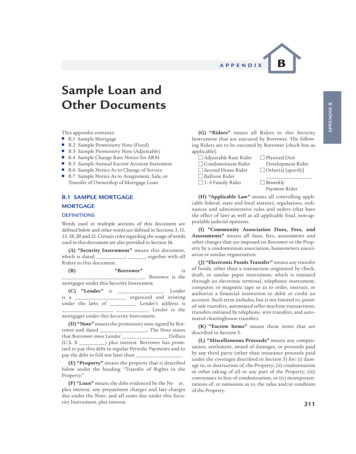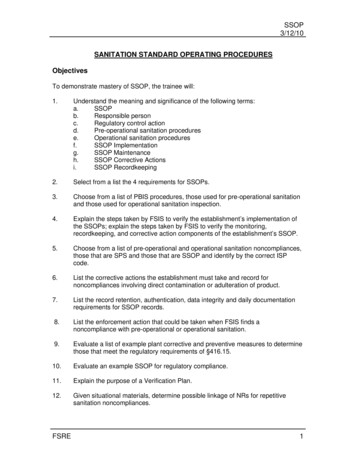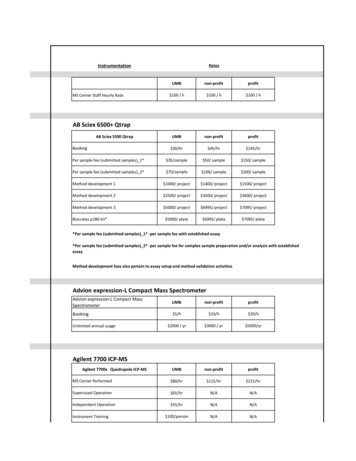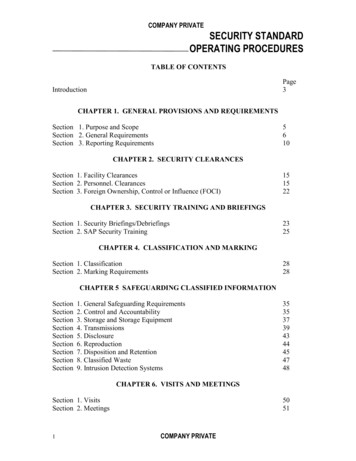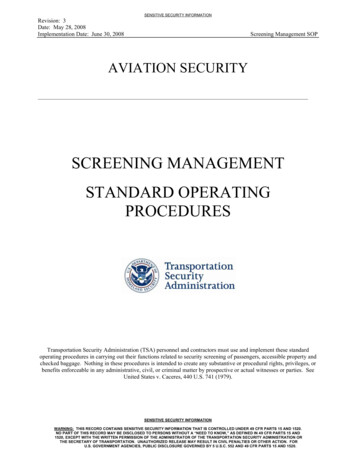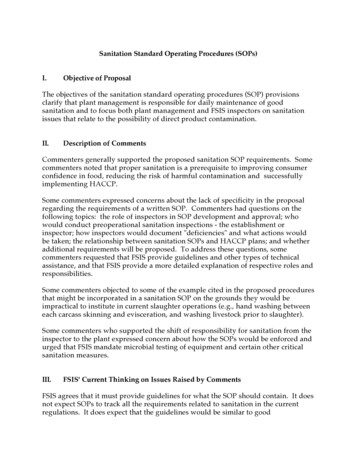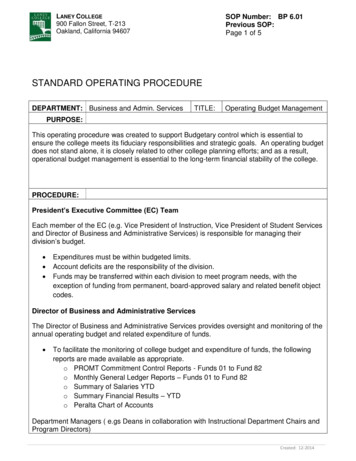
Transcription
Essential Standard Operating ProceduresSample TemplatesTable of ContentsIntroductionStudy Conduct and Good Clinical Practice1: JHM Training/Certification Documentation2: Delegation of Responsibility3: Process for Obtaining Informed Consent4: Documenting Informed Consent5: Documenting Eligibility Assessment6: Submitting Changes in Research7: Protocol Deviation Reporting and Documentation8: Reporting Study Non-Compliance9: Reporting Unanticipated Problems/Events10: Reporting the Death of a JHM Research ParticipantSubject Information/Data11: Study Subject Data Collection12: Paper Case Report Form Design and Use13: Site Generated Electronic Case Report FormsFDA Regulated Studies and Principal Investigator Responsibilities14: Responsibilities for FDA Regulated Research15: Required Reporting to FDA IND Studies16: Sponsor-required Written General Monitoring Plan for FDA IND Studies17: Drug Accountability18: Required Reporting to FDA IDE Studies19: Sponsor-required Written General Monitoring Plan for FDA IDE Studies20: IDE Device Accountability - Receipt and Storage21: IDE Device Accountability - Usage of Device22: IDE Device Accountability – Device ReturnRegulatory Procedures23: Regulatory Documentation Organization24: Retention of Study Records25: Writing Standard Operating Procedures26: Note-to-File
JHM IRB COMPLIANCE GUIDE FOR DEVELOPINGSTANDARD OPERATING PROCEDURESINTRODUCTIONThe Compliance Monitoring Team has created Standard Operating Procedure templates(SOPs) in response to action items discovered in IRB directed audits, FDA audit and sitevisits, and routine monitoring visits. These templates were designed in order to assistresearchers in establishing their own set of rules, or SOP criteria, and to help study staffoperate their respective studies in an organized and consistent manner, that demonstratesadherence to Federal regulations and Institutional guidance. The SOP templates and thecorresponding Case Report Form/checklists cover the basic categories of studyprocedures and can be applied across studies. SOP samples are available below.Samples of the SOPs listed here include: How to obtain Informed Consent from research subjectsDocumenting the Informed Consent processMaintaining Regulatory DocumentsStudy Record retentionSerious Adverse Event reportingSafety Reporting for routine Adverse Events and Protocol DeviationsThe templates follow a formal format that includes the following structure:I.A “header” indicating the title, date, author, version number, pages, and approvalinformation (if applicable).II.The body of the document includes the purpose, scope, references (if applicable),and a number of detailed procedures.When developing your own specific SOPs, you may consider using a less formalstructure. If your study requires more specific content, please consider tailoring yourindividual site and/or protocol Standard Operating Procedures to suit your needs.Other areas to consider when designing your site-specific SOPs: Communication Procedures (IRB, NIH, FDA, Sponsor, other)Protocol Continuing RenewalProtocol TerminationIND Safety reportsIND Annual reportsIND Sponsor-required Written General Monitoring PlanIDE Progress ReportsIDE Unanticipated Adverse Device Effect ReportingIDE Sponsor-required Written General Monitoring PlanWithdrawal of SubjectsOral Consent processAssent and Consent of MinorsChange In PI /Inherited studiesDSMB Reporting requirement
Sample User Standard Operating ProcedureStatus:Original Date:Revision Date:Version:Revised by:Approved by:Approval Date:Standard Operating Procedures: JHM Training/Certification DocumentationThe Principal Investigator is responsible for:1.Completing and passing the following training modules:a.b.c.d.Human Subjects Research ComplianceCourse on Research Ethics (C.O.R.E)Conflict of InterestHIPAA and Research Course2.Designating study personnel as “consent designees” who, upon being approved by the IRB toobtain informed consent, shall receive training in the consent process.3.Assuring the training of all applicable research personnel regarding study procedures, studyconduct, and research compliance.4.Performing additional training and certification as required by the Institution, sponsor, or otherregulatory authorities, with such certificates retained for verification.5.Maintaining a record for all Research Personnel of all training certifications, including allcertificates of completion of applicable training modules and, if necessary, any sponsor requireddocuments (e.g., CVs) in the Regulatory Binder. Use the specific table template found in sectionII.B.2 of this manual.
Sample User Standard Operating ProcedureStatus:Original Date:Revision Date:Version:Revised by:Approved By:Approval Date:Standard Operating Procedures: Delegation of ResponsibilityThe Principal Investigator is responsible for:1.Designating all Co-Investigators and other research personnel on theinitial review application submitted to the IRB.2.Ensuring that co-investigators have read and understood the protocol and their specific rolein the research, and all other study-related materials (e.g., the investigator brochure, ifapplicable).3.Assigning specific tasks and responsibilities for each member of the study team; andcommunicating and providing training for these roles and responsibilities to each member.4.Authorizing all members of the study team, who are included in the initialapplication or later added to the protocol, to perform specific study related tasks but onlyafter receiving approval from the IRB.5.Maintaining a study responsibility delegation table on which all study team members arenamed, their respective duties/tasks are outlined, and each member’s entry is signed anddated to indicate the team member’s willingness to perform his/her designated tasks. Use thespecified table found in Section II.B.1 in this manual.
Sample User Standard Operating ProcedureStatus:Original Date:Revision Date:Version:Revised by:Approved By:Approval Date:Standard Operating Procedures: Process for Obtaining Informed ConsentThe Principal Investigator and IRB approved study staff members are responsible for:1.Describing in the IRB application (eFormA) how, when, and where, and by whom informedconsent will be obtained. In addition, establishing the following elements to the informedconsent process:a.b.c.d.Presenting the research subject with adequate opportunity to read the entireinformed consent form before it is signed, which may include taking thedocument home to discuss with family, prior to signing.Allowing the subject and/or subject’s legally authorized representative ampletime and opportunity to ask questions about the study. All questions shouldbe answered to the satisfaction of the subject and/or the subject’s legallyauthorized representative.Assessing and confirming the subject’s comprehension of the InformedConsent Form content.Obtaining legally effective informed consent (i.e. signed, dated and, ifapplicable, witnessed) from the subject or the subject’s legally authorizedrepresentative, prior to the initiation of any study specific procedures.2.Implementing and consistently following the IRB approved consent process.3.Training, if applicable, study team member approved as consent designees on the process ofobtaining informed consent.4.Signing and dating the IRB approved written informed consent form on the same day as thesubject and/or the subject’s legally authorized representative.5.Giving a copy of the informed consent form, signed by the subject, to the subject, and filinganother in the subject’s medical record (if applicable); the original should remain in thesubject’s research record.
Sample User Standard Operating ProcedureStatus:Original Date:Revision Date:Version:Revised by:Approved By:Approval Date:Standard Operating Procedures: Documenting Informed ConsentThe Principal Investigator is responsible for:1.Documenting the IRB approved informed consent process was followed by recording andconfirming the following information:a.b.c.d.e.The current IRB approved (noting the version number and expiration date)consent form was used, and signed by the subject;The name of the person who discussed the consent form with the potentialsubject;The name of the person who obtained the consent form signature(s) from theresearch subject (additional witness, or proxy); or why it was not obtained;The date of subject and investigator (or IRB approved consent designee)signatures;Verification that a copy of the signed consent was given to the subject, that theoriginal remains in the research record, and that a copy is filed in the medicalrecord, if applicable.2.Verifying the validity of the informed consent form, and assuring proper completion of theapproved informed consent process, using the Informed Consent Process checklist found inSection, II.A.1 of this manual.3.Filing the valid, signed and dated consent form, along with any supporting documentation(e.g., a consent process checklist), in the subject’s research record.
Sample User Standard Operating ProcedureStatus:Original Date:Revision Date:Version:Revised by:Approved By:Approval Date:Standard Operating Procedures: Documenting Eligibility AssessmentThe Principal Investigator or authorized staff is responsible for:1.Describing in the IRB application (eFormA) all procedures used to determine eligibility andhaving these procedures approved by the IRB.2.Completing IRB approved eligibility verification tasks to determine that all study inclusionand exclusion criteria are met prior to study enrollment.3Ensuring that appropriate documentation is kept in the subject’s research record toconfirm study eligibility, including all study-related, clinically obtained information (i.e.,“source documentation”) used to qualify a subject for study enrollment.4.Developing and utilizing a study-specific checklist (or sponsor provided form) containingstudy eligibility criteria, using the template in Section II.A.2 of this manual. This checklistshould be signed and dated by the person performing the eligibility assessment andcompleting the form.
Sample User Standard Operating ProcedureStatus:Original Date:Revision Date:Version:Revised by:Approved By:Approval Date:Standard Operating Procedures: Submitting Changes in ResearchThe Principal Investigator is responsible for:1.Requesting and obtaining IRB approval for all proposed changes to the protocol or informedconsent form, and documenting IRB approval prior to executing any such changes.2.Determining the level of modification and describing it to the IRB as:a.b.3.A major modification, which involves a change to the protocol and consent, orA minor or administrative modification, which may not necessitate a change tothe protocol or consent form.Submitting a “Change in Research Application” to the IRB, accompanied by alldocumentation affected by the proposed changes, including:a.b.c.d.e.Sponsor’s protocol; orIRB Protocol Form A; and/orContinuing Review Application (change should be summarized); and/orInformed Consent Form; and/orAny new documents/materials added to the approved protocol.4.Retaining in the site’s Regulatory File all documentation and IRB correspondence regardingall changes to an approved protocol or consent.5.Keeping track all modifications to the protocol or consent form, and when such changes wereIRB approved, using the Changes in Research Log found in Section II.C.2 in this manual.
Sample User Standard Operating ProcedureStatus:Original Date:Revision Date:Version:Revised by:Approved By:Approval Date:Standard Operating Procedures: Protocol Deviation Reporting and DocumentationThe Principal Investigator is responsible for:1.Conducting the study in accordance with the IRB approved protocol as it is written.2.Not making any non-emergent changes to, or deviating from, the IRB approved protocol withoutprior notification to and approval from the IRB as an approved Change in Research.3.Submitting administrative and minor deviations that precipitate a change to the protocol (per theIRB’s flow diagram: .pdf, and Section IV ofthis manual) to the IRB for approval using the “Changes in Research” application.4.Recording any minor or administrative deviation from the approved protocol that do notprecipitate a change to the protocol by utilizing the Deviation Tracking Log found in SectionII.C.1 of this manual, and submitting this information to the IRB in the annual continuing reviewapplication.
Sample User Standard Operating ProcedureStatus:Original Date:Revision Date:Version:Revised by:Approved By:Approval Date:Standard Operating Procedures: Reporting Study Non-ComplianceThe Principal Investigator is responsible for:1.Notifying the IRB of any incident where the IRB approved protocol was not followed, orFederal, state, and/or Institutional regulatory requirements or directives were overlooked.2.Informing the IRB of the immediate specific response to reconcile the incident or oversight.3.Describing to the IRB a corrective action plan, which may includea. site personnel educational/trainingb. change(s) to the research protocol to minimize the recurrence of incidences of noncompliance.
Sample User Standard Operating ProcedureStatus:Original Date:Revision Date:Version:Revised by:Approved By:Approval Date:Standard Operating Procedures: Reporting Unanticipated Problems/EventsThe Principal Investigator is responsible for:1.Reporting the following specific unanticipated problems or events to the JHM IRB:a.b.c.d.e.f.g.h.i.Events such as injuries, side-effects, breaches of confidentiality (includinglost/stolen computers, hard copy files, magnetic storage media, etc.), or otherproblems that1) harm or increase the risk of harm to the subject or others2) are unexpected (i.e., not described in the consent form or study)3) AND are related to research procedure(s).New Information that changes the risks or potential benefits of the research asdescribed in the consent form.Any FDA restriction on a marketed drug, device, or biologic used in research.Any emergent change to the protocol to reduce immediate harm to subject.(Such reports will almost always include a “Change to Research” applicationto address the protocol limitation that caused the emergent change.)Incarceration of the subject.Any event that requires prompt reporting to the study sponsor(s).Subject complaint that indicates an unanticipated risk, or remains unresolvedby the research team.Protocol violation (meaning an accidental or unintentional change to the IRBapproved protocol) that placed one or more participants at increased risk, orhas the potential to occur again.An unexpected adverse device event for IDE studies.3.Reporting Unanticipated Problems to the IRB promptly, in between 3 and 10 working days,depending upon the seriousness of the problem/event (per the IRB reporting process flowdiagram: art.pdf and Section IV of thismanual).4.Using the most current IRB Unanticipated Problem Event Notification form(http://irb.jhmi.edu/Forms/RF1.doc).5.Keeping a log of Unanticipated Problems/Events submitted to the IRB, using the log-sheetfound in http://irb.jhmi.edu/Forms/RF3.doc or Section II.C.3 of this manual.
Sample User Standard Operating ProcedureStatus:Original Date:Revision Date:Version:Revised by:Approved By:Approval Date:Standard Operating Procedures: Reporting a Death of a JHM ResearchParticipantThe Principal Investigator is responsible for:1.Reporting to the IRB within three (3) working days, the death of a JHM research participantthat occurs within 30 days of the study intervention, and that isa. Unexpected and unrelated to the risks described in the IRB approved Informed Consentand protocol, ANDb. More likely than not, caused by a research procedure or intervention.2.Reporting the IRB within ten (10) working days, the death of a JHM research participant thatisa. Expected due to the subject’s underlying condition or disease state, ORb. Expected as identified as a risk in the approved Informed Consent form and protocol.3.Reporting to other regulatory authorities (FDA, NIH, etc.) and/or to the Sponsor, if applicable.4.Recording and retaining all documentation associated with the Death and filing thesematerials in the Subject’s research record.
Sample User Standard Operating ProcedureStatus:Original Date:Revision Date:Version:Revised by:Approved By:Approval Date:Standard Operating Procedures: Study Subject Data CollectionThe Principal Investigator and authorized Study Team members are responsible for:1.Ensuring the accuracy, completeness, legibility, and timeliness of the data entered in sponsorprovided Case Report Forms (CRFs) or customized data collection forms, and in all requiredreports, including logs and checklists.2.Recording observed data (or data derived from source documents) consistently, or explainingany discrepancies in a Note-to-File, using the template found in Section II.D. of this manual.3.Designating members of the staff who are authorized to change or correct data entries.4.Conforming to the following steps in regards to any changes or corrections to a CRF,progress note, research lab result, etc.:a. Draw a single line through the incorrect entry;b. Date and initial the strike-through;c. Enter the correct information and/or explanation proximal to the original entry.d. Instruct staff that correction-fluid cannot be used to make corrections.5.Establishing a research record review process, to check data accuracy.
Sample User Standard Operating ProcedureStatus:Original Date:Revision Date:Version:Revised by:Approved By:Approval Date:Standard Operating Procedures: Paper Case Report Form Design and UseThe Principal Investigator and authorized Study Team Members are responsible for:1.Including information in the header of the paper Case Report Form (CRF) to identify the site,the specific protocol title (and study number, if applicable), and the IRB approval number.2.Creating the body of the CRF to include fields for:a.b.c.d.Unique Subject IDVisit DateSpecific visit number/interval, if applicableSection(s) for Visit specific data3.Using additional space in the footer for signature of study personnel who may complete theCRF, the date of CRF completion, and the Principal Investigator/Co-Investigator’s signatureto demonstrate a review of the CRF for completion, accuracy, and overall quality control.4.Completing the CRF in black ink.5.Making a single line strike-out of the errant data, the necessary correction(s), and the initialand date of the personnel making the correction. Correction-fluid can not be used.
Sample User Standard Operating ProcedureStatus:Original Date:Revision Date:Version:Revised by:Approved By:Approval Date:Standard Operating Procedures: Site Generated Electronic Case Report FormsThe Principal Investigator and authorized Study Team Members are responsible for:1.Entering information in the site-generated electronic Case Report Form (CRF) or databaserecord to identify the site, the specific protocol title (and study number, if applicable), and theIRB approval number.2.Completing site-generated CRF or database fields to indicatea.b.c.d.Unique Subject IDVisit DateSpecific visit number/interval, if applicableSection(s) for Visit specific data3.Using additional fields in the electronic CRF record, for the electronic signature of studypersonnel authorized to complete the CRF, the time/date stamp of CRF completion,and the Principal Investigator/Co-Investigator’s electronic signature to demonstrate a reviewof the CRF for completion, accuracy, and overall quality control.4.Maintaining an electronic audit trail to keep track of corrections/additions to the database andelectronic case report form record(s), who made them, and when via user IDs and time/datestamping routines.5.Employing adequate security clearance, encryption, archiving, and recovery systems tomaximize secure access, subject confidentiality, and record-retention quality assurance.
Sample User Standard Operating ProcedureStatus:Original Date:Revision Date:Version:Revised by:Approved By:Approval Date:Standard Operating Procedures: Responsibilities for FDA Regulated ResearchThe Principal Investigator conducting IND (new Drug) or IDE (new Device) research is responsiblefor:1.Conducting the study in accordance with the most current, IRB approved protocol.2.Notifying the sponsor (in commercially funded research) prior to making changes to theprotocol, except when necessary to protect the safety, rights, or welfare of subjects.3.Personally conducting or supervising the investigation.4.Informing the subject that the study drug or device is being used for investigationalpurposes, and obtaining informed consent.5.Reporting to the sponsor adverse experiences that occur in the course of the investigation.6.Reading and understanding the information in the investigator's brochure (For IND/IDEresearch), including the potential risks and side effects of the drug or device.7.Ensuring that all associates, colleagues, and employees assisting in the conduct ofthe study are informed about their obligations in meeting the above commitments.8.Maintaining adequate and accurate records, and making those records available forinspection by the FDA, Institution, or any authorized regulatory body.9.Obtaining initial and continuing review and approval of the clinical investigation.10.Promptly reporting to the IRB all changes in the research activity and all unanticipatedproblems involving risks to human subjects or others.11.Awaiting IRB approval, prior to making any changes in the research except wherenecessary to eliminate apparent immediate hazards to human subjects.12.Complying with all other requirements regarding the obligations established in 21 CFR Part312 (Drug research) or 21 CFR 50, 812 (Device research).
Sample user Standard Operating ProcedureStatus:Original Date:Revision Date:Version: 1Revised by:Approved by:Approval Date:Standard Operating Procedure: Establishing a General Monitoring Plan for theFDA IND ApplicationIn compliance with 21 CFR 312.50 and 53, the JHM sponsor/investigator of an InvestigationalNew Drug (“IND”) application is responsible forProcedures:1. Selecting a Monitor or Monitors to oversee the conduct of the protocola. The sponsor will designate one or more monitors, as appropriate.i. The sponsor may select an individual to carryout monitoringii. The sponsor may elect to sub-contract any and all monitoring to aContract Research Organization (CRO)b. Each monitor shall have proper education, certification, and or other necessaryqualifications to perform monitoring duties.c. The Monitor(s) should be chosen based upon the investigation’s scope, scale,complexity, investigative agent(s), and disease/condition of the populationbeing studied.d. If applicable to the study, the designated monitor(s) shall remain blinded tostudy-arm assignments.2. Establishing a General Monitoring Plana. The Monitoring Plan can be adapted for the needs of an individual studyb. The basic operations of a monitoring plan includei. Designating a monitor or monitors, per Step #1 aboveii. Instituting a written Monitoring schedule to review the progress of thestudy, including1. A pre-investigation visit to confirma. the investigator(s) and research site are preparedb. the investigator(s) is(are) aware of the applicableresponsibilities, as outlined on FDA Form 1572 and theFDA’s monitoring ns/BioresearchMonitoring/ucm135075.htmc. the study staff is adequately qualified, educated, and/ortrained to conduct the study2. Periodic or interim visits to review and confirma. regulatory documentation for compliance with allapplicable regulations and requirementsb. study test-article accountability
Sample user Standard Operating ProcedureStatus: FinalOriginal Date:Revision Date:Version:Revised by:Approved by:Approval Date:c. all changes to research have been submitted andapproved by the IRBd. the continued adequacy of the facility and its resourcesfor the conduct of the studye. the investigator is following the protocolf. the study team membership and delegation ofresponsibilities are current and IRB approved3. Close-out monitoring visit toa. reconcile any outstanding regulatory documentationissuesb. resolve outstanding research participant matters (e.g.,following “adverse events” to resolution, outstandingfollow-up visits, etc.)c. correct any residual data-queriesiii. An inspection of a portion, but not excluding all, of the researchsubject record for1. proper informed consent procedures2. subject eligibility, with source documentation to confirm3. protocol compliance4. data integrity, consistency, and correctness5. safety reporting6. protocol deviations are noted and reportediv. Generation of a written report identifying the monitoring findings,including1. What regulatory compliance issues were observed andcorrected2. What research record deficiencies were noted and correctedv. A process for distributing the monitoring report(s) to the sponsor andindividual investigator(s) receiving an on-site monitoring visitvi. A monitoring/on-site visit record maintained by the sponsor and/ormonitor, documenting1. When the monitoring was completed2. Who conducted the monitoring
Sample User Standard Operating ProcedureStatus:Original Date:Revision Date:Version:Revised by:Approved By:Approval Date:Standard Operating Procedures: Required Reporting for FDA IND/IDE StudiesThe Principal Investigator, as sponsor-investigator, is responsible for:1.Determining an event to be a reportable adverse drug reaction as:a.b.c.life-threatening (i.e., the subject is at immediate risk of death); and/orunexpected (i.e., not known to the PI); and/orserious (i.e., resulting in death, hospitalization, disability, or congenitalanomaly).2.Notifying the FDA by phone or fax immediately, but in no more than 7 days, if conditions a,b, or c are established.3.Completing the FDA MEDWATCH Form 3500A, or a narrative report (identified as an INDSafety Report, if applicable) and submitting the documentation to the FDA as soon aspossible, but in no more than 15 days, if the above conditions a, b, or c are established.4.Submitting supporting documentation for any event that meets the criteria for promptreporting to the IRB, utilizing the Problem Event Form in the required time-frame.5.Sending required annual progress and safety summary reports with the FDA, per 21 CFR312.33 (IND) or 21 CFR 812.36 (IDE).
Sample User Standard Operating ProcedureStatus:Original Date:Revision Date:Version:Revised by:Approved By:Approval Date:Standard Operating Procedures: Drug AccountabilityThe Principal Investigator or authorized Study Team Members, if not utilizing the JHMInvestigational Drug Service (IDS), are responsible for:1.Receiving the study druga.Maintain adequate records confirming the receipt, shipment, expiration dates, orother disposition information of the investigational drug.b.Documenting any discrepancies.c.Assuring that records include the name of the individual to whom the drug isshipped, the date, quantity, and batch/code number for each shipment.d.Verifying shipment with packing slip or invoices.2.Storing the study druga.Securing drug in a locked storage area, and, if applicable, monitoring to assureproper storage conditions.b.Completing regular inventory to assure balance among stock received,dispensed, and returned.3.Labeling the study drug for product dispensed to subjectsa.Prior to dispensing the study drug, generating a label to include the datedispensed; drug name; drug strength, dose, quantity, and expiration information;subject’s identifier; PI’s contact information; and directions for use.b.Affixing the label to the dispensed drug.4.Prescribing the study druga.For all pharmacy-based IND drug studies, completing the Investigational DrugData Sheet with information on the dispensing procedure and/or the list ofauthorized prescribers.b.For drug products requiring a prescription, the PI or Co-I will follow applicableJHH and State prescription policies.5.Dispensing and Drug Disposition with the following informationa.Date dispensed/administeredb.Patient initials/Identifierc.Drug name as defined for this study (does not necessitate unblinding)d.Drug strength (unless blinded)e.Quantity dispensed/administeredf.Lot number (unless dispenser is blinded to this)g.Initials of dispenser/person administering drugh.Date and amount of patient returns documented in study records (this is returneddrug that cannot be dispensed again)6.Returning the study druga.Documenting drug supply return indicating date sent, quantity (including lotnumbers), and names of sender and receiver.b.Documenting, if applicable, date, amount, and method of destruction.
Sample User Standard Operating ProcedureStatus:Original Date:Revision Date:7.Version:Revised by:Approved By:Approval Date:Documentinga.Filing all drug documentation within a dedicated section of the study records.b.Utilizing the IDS Drug Audit form for required procedures.c.Employing a Drug Accountability Log sheet to track items 1-6.
Sample User Standard Operating ProcedureStatus:Original Date:Revision Date:Version:Revised by:Approved By:Approval Date:Standard Operating Procedures: Required Reporting to FDA for IDE studiesThe Principal Investigator, as sponsor-investigator, is responsible for:1.Determining an event to be an Unanticipated Adverse Device Effect as:a.b.c.d.a serious adverse effect upon the subject’s health or safety; and/oris life-threatening; and/orresults in death; andwas unexpected2.Or determining the event to be a Product Problem that could lead to a death or serious injuryif the malfunction were to recur.3.Completing the FDA MEDWATCH Form 3500A, or a narrative report, and submitting thedocumentation to the FDA as soon as possible, but in no more than 10 days after discovery ofthe event
Study Conduct and Good Clinical Practice . 1: JHM Training/Certification Documentation . 2: Delegation of Responsibility . 3: Process for Obtaining Informed Consent . 4: Documenting Informed Consent . 5: Documenting Eligibility Assessment . 6: Submitting Changes in Research . 7: Protocol Deviation Reporting and Documentation


